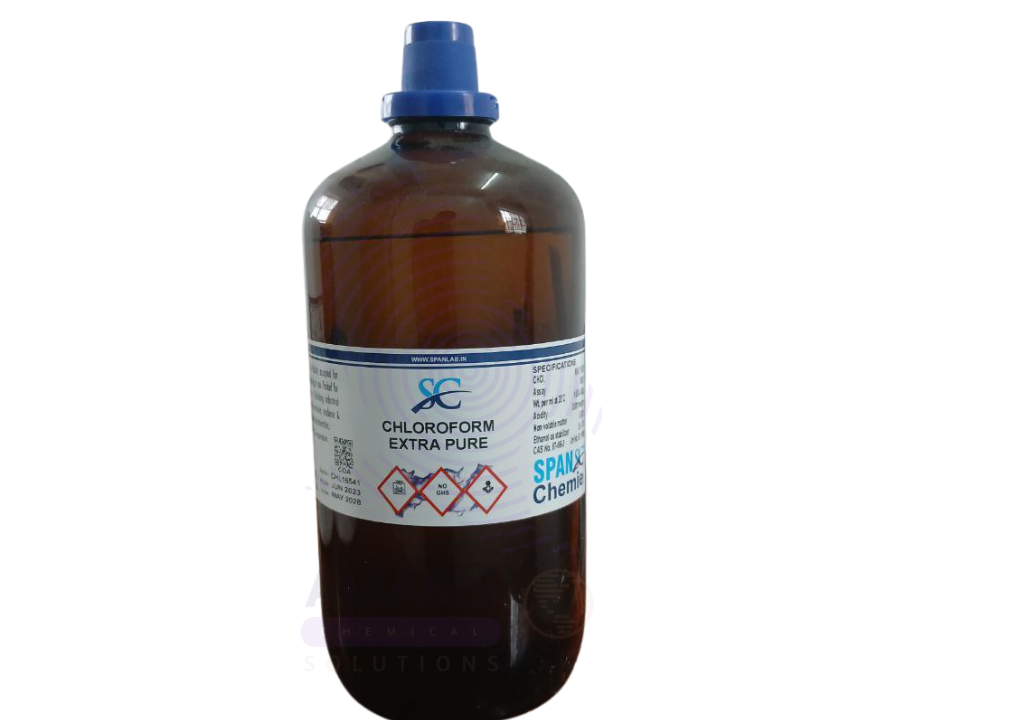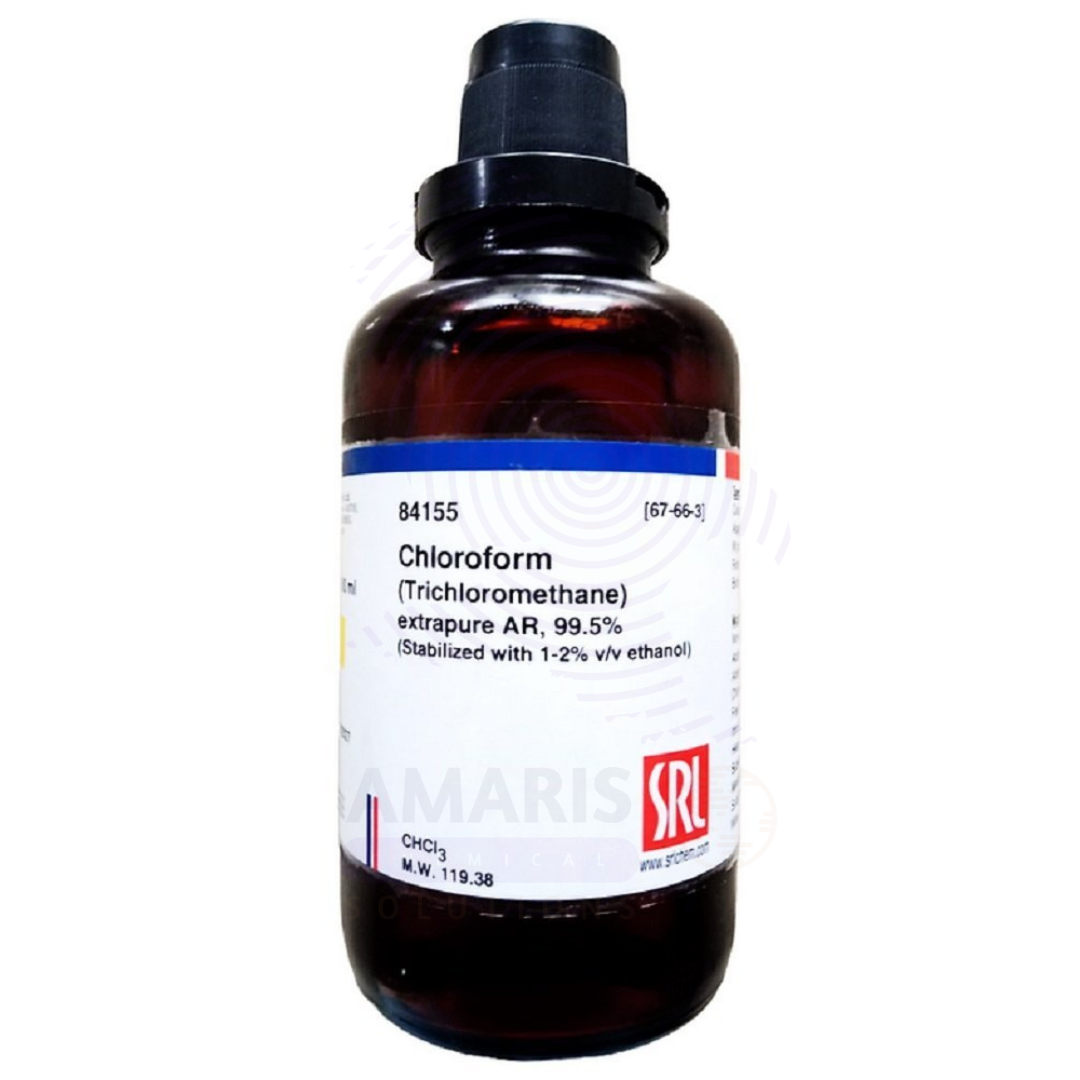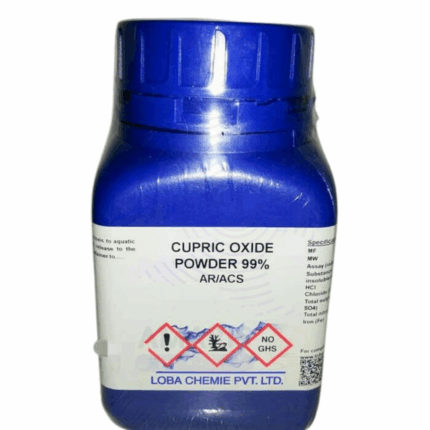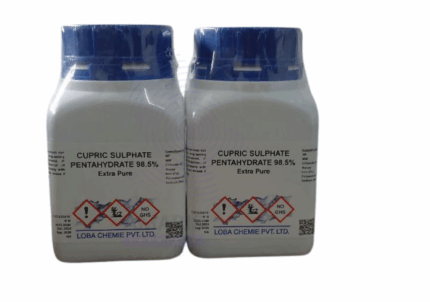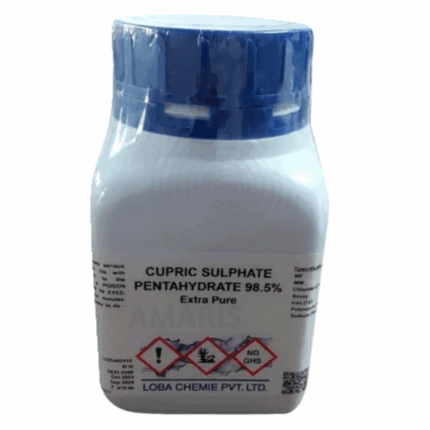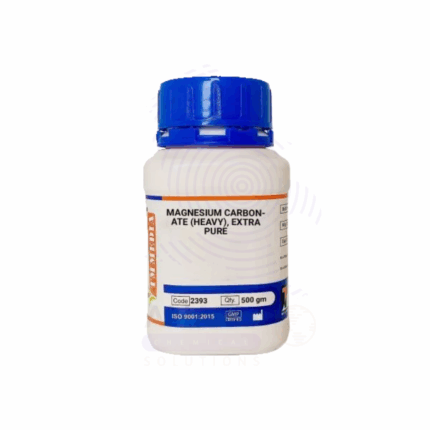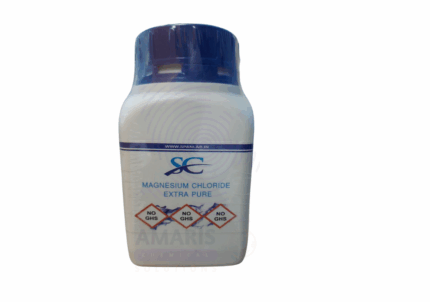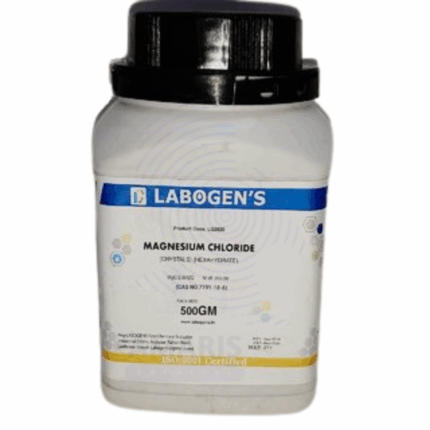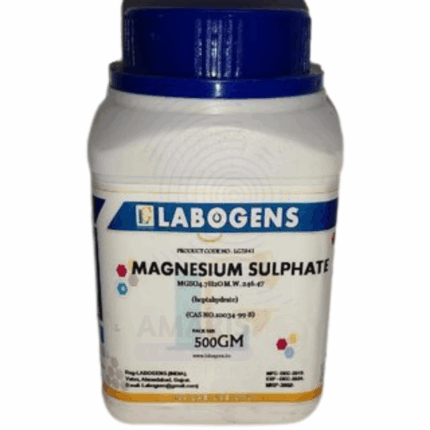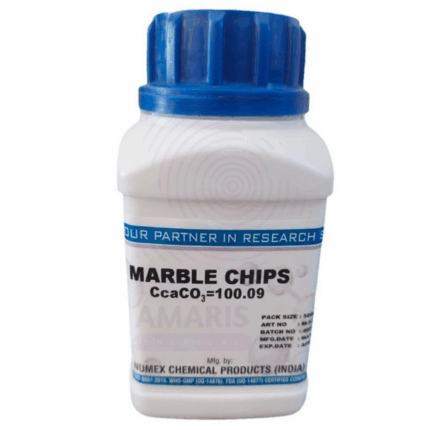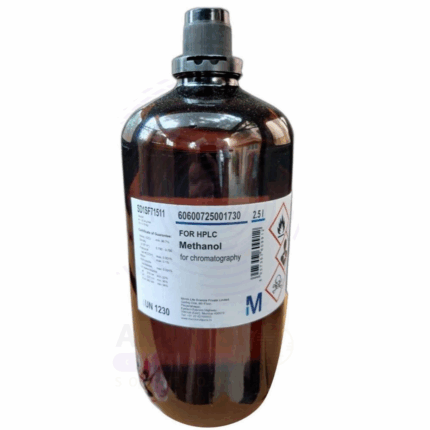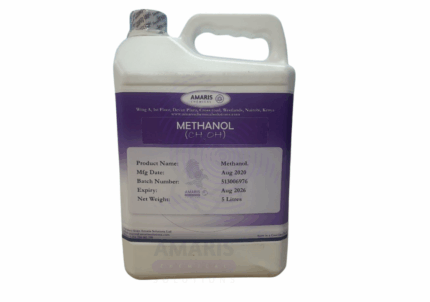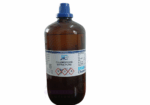
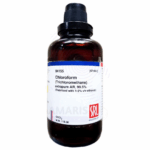
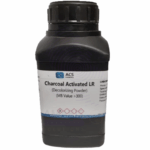
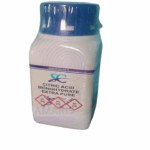
Chloroform Extra Pure
$ 38.25 Original price was: $ 38.25.$ 38.12Current price is: $ 38.12.
Chloroform Extra Pure is a high-purity, colorless, and volatile liquid commonly used in laboratory environments as a solvent, reagent, and extraction medium. Due to its excellent solvency for fats, alkaloids, and other organic compounds, it plays a key role in organic synthesis, chromatography, and sample preparation. In molecular biology, it is frequently used in nucleic acid extraction protocols. The extra pure grade ensures low levels of impurities, making it suitable for analytical and research applications that demand high accuracy. It must be handled with proper ventilation, protective equipment, and stored away from light and heat to prevent decomposition and formation of toxic by-products like phosgene.
Chloroform Extra Pure
Primary Uses
- Organic Solvent for Extractions
- Widely used in liquid-liquid extraction, especially to isolate alkaloids, lipids, and other nonpolar compounds due to its high solubility for hydrophobic substances.
- DNA/RNA Extraction Reagent
- Essential in phenol-chloroform extraction protocols for separating nucleic acids from proteins in molecular biology labs.
- Reagent in Organic Synthesis
- Used in reactions involving halogenated intermediates, such as the Reimer–Tiemann reaction to form aromatic aldehydes from phenols.
- Sample Preparation for Spectroscopy
- Occasionally used to dissolve compounds before IR or NMR analysis when non-aqueous solvents are required.
Secondary Uses
- Cleaning Solvent in Analytical Labs
- Employed (with caution) for cleaning glassware or removing organic residues in delicate analytical setups.
- Solvent for Pesticide Residue Analysis
- Used in some GC-MS sample preps for dissolving or concentrating analytes from environmental or agricultural samples.
- Reference Material in Spectroscopy
- Chloroform-d (deuterated chloroform) is a standard solvent for ¹H and ¹³C NMR, but non-deuterated chloroform can also be used as a comparative solvent.
| PACK SIZE |
2.5 Litres Glass bottle |
|---|
1. Basic Identification Attributes
- Chemical Name: Chloroform
- CAS Number: 67-66-3
- HS Code: 2903.11.00
- Molecular Formula: CHCl₃
- Molecular Weight: 119.38 g/mol
- Synonyms: Trichloromethane, Methane trichloride
2. Physical & Chemical Properties
- Appearance: Clear, colorless, volatile liquid
- Odor: Sweet, ether-like
- Boiling Point: 61.2°C
- Melting Point: -63.5°C
- Density: 1.489 g/cm³ at 20°C
- Solubility: Slightly soluble in water (8 g/L), miscible with ethanol, ether, benzene
- Vapor Pressure: ~213 mmHg at 25°C
- Refractive Index: 1.4459 (at 20°C)
- Flash Point: Non-flammable (liquid), but vapors may decompose under flame
- Autoignition Temperature: 982°C
3. Safety & Hazard Attributes
- GHS Classification:
- H302: Harmful if swallowed
- H315: Causes skin irritation
- H319: Causes serious eye irritation
- H336: May cause drowsiness or dizziness
- H351: Suspected of causing cancer
- H361: Suspected of damaging fertility or the unborn child
- H373: May cause damage to organs through prolonged or repeated exposure
- NFPA Ratings:
- Health: 2
- Flammability: 1
- Reactivity: 0
- Exposure Limits:
- OSHA PEL: 50 ppm (TWA)
- ACGIH TLV: 10 ppm (TWA)
- First Aid Measures:
- Inhalation: Remove to fresh air; seek medical attention
- Skin/Eyes: Rinse immediately with water for at least 15 minutes
- Ingestion: Do NOT induce vomiting; seek immediate medical attention
4. Storage & Handling Attributes
- Storage Conditions:
- Store in a tightly sealed amber glass container
- Keep in a cool, dry, well-ventilated area away from light and heat
- Protect from air and moisture to prevent decomposition
- Container Type: Amber glass bottle with secure chemical-resistant cap
- Incompatible Materials: Alkalis, strong bases, reactive metals, strong oxidizers
- Stability: Light-sensitive; decomposes slowly in air and light to form phosgene (toxic)
- Shelf Life: ~2 years (with proper inhibitor and storage)
5. Regulatory & Compliance Attributes
- Transportation (UN Number):
- UN 1888 – Chloroform
- Class: 6.1 (Toxic Substances)
- Packing Group: III
- Waste Disposal Method:
- Dispose as hazardous waste in accordance with local regulations
- Do not pour down the drain or mix with incompatible substances
6. Environmental & Health Impact
- Ecotoxicity: Harmful to aquatic organisms; avoid environmental release
- Persistence: Volatile, not readily biodegradable
- Bioaccumulation: Low to moderate potential
- Carcinogenicity: IARC Group 2B – Possibly carcinogenic to humans
SAFETY PRECAUTIONS
- PPE Required:
- Lab coat
- Chemical-resistant gloves (e.g., Viton or nitrile)
- Safety goggles or face shield
- Use a certified chemical fume hood (strictly required)
- Handling:
- Handle in a well-ventilated area only inside a fume hood.
- Avoid inhalation, ingestion, and skin contact.
- Keep away from heat, sparks, and open flame.
- Storage:
- Store in tightly closed, amber glass containers.
- Keep in a cool, dry, well-ventilated area.
- Protect from light and moisture (may form phosgene when exposed to air/light).
- Store away from oxidizers, alkalis, and reactive metals.
FIRST AID MEASURES
- Inhalation:
- Move the person to fresh air immediately.
- Give oxygen if breathing is difficult.
- Seek urgent medical attention (chloroform is a CNS depressant).
- Skin Contact:
- Wash immediately with soap and plenty of water for at least 15 minutes.
- Remove contaminated clothing.
- Get medical help if irritation or pain persists.
- Eye Contact:
- Flush eyes thoroughly with water for at least 15 minutes.
- Lift eyelids occasionally.
- Seek immediate medical attention.
- Ingestion:
- Do not induce vomiting.
- Rinse mouth with water.
- Seek immediate medical attention (chloroform is toxic and hepatotoxic).
FIREFIGHTING MEASURES
- Flammability:
- Non-flammable but may decompose when heated to produce toxic gases (phosgene, HCl, CO).
- Suitable Extinguishers:
- Dry chemical
- Carbon dioxide
- Alcohol-resistant foam
- Fire Hazards:
- Containers may explode under high heat.
- Thermal decomposition may release phosgene gas (highly toxic).
- Firefighting Gear:
- Full protective gear and self-contained breathing apparatus (SCBA) mandatory.
- Full protective gear and self-contained breathing apparatus (SCBA) mandatory.


 Preservatives(food)
Preservatives(food) Flavor Enhancers
Flavor Enhancers Acidulants
Acidulants Sweeteners
Sweeteners Antioxidants
Antioxidants Colorants(food)
Colorants(food) Nutraceutical Ingredients (food)
Nutraceutical Ingredients (food) Nutrient Supplements
Nutrient Supplements Emulsifiers
Emulsifiers
 Collectors
Collectors Dust Suppressants
Dust Suppressants Explosives and Blasting Agents
Explosives and Blasting Agents Flocculants and Coagulants
Flocculants and Coagulants Frothers
Frothers Leaching Agents
Leaching Agents pH Modifiers
pH Modifiers Precious Metal Extraction Agents
Precious Metal Extraction Agents
 Antioxidants(plastic)
Antioxidants(plastic) Colorants (Pigments, Dyes)
Colorants (Pigments, Dyes) Fillers and Reinforcements
Fillers and Reinforcements Flame Retardants
Flame Retardants Monomers
Monomers Plasticizers
Plasticizers Polymerization Initiators
Polymerization Initiators Stabilizers (UV, Heat)
Stabilizers (UV, Heat)
 Antifoaming Agents
Antifoaming Agents Chelating Agents
Chelating Agents Coagulants and Flocculants
Coagulants and Flocculants Corrosion Inhibitors
Corrosion Inhibitors Disinfectants and Biocides
Disinfectants and Biocides Oxidizing Agents
Oxidizing Agents pH Adjusters
pH Adjusters Scale Inhibitors( water)
Scale Inhibitors( water)
 Antioxidants(cosmetic)
Antioxidants(cosmetic) Emollients
Emollients Fragrances and Essential Oils
Fragrances and Essential Oils Humectants
Humectants Preservatives
Preservatives Surfactants(cosmetic)
Surfactants(cosmetic) Thickeners
Thickeners UV Filters
UV Filters
 Fertilizers
Fertilizers Soil Conditioners
Soil Conditioners Plant Growth Regulators
Plant Growth Regulators Animal Feed Additives
Animal Feed Additives Biostimulants
Biostimulants Pesticides (Herbicides, Insecticides, Fungicides)
Pesticides (Herbicides, Insecticides, Fungicides)
 Active Pharmaceutical Ingredients (APIs)
Active Pharmaceutical Ingredients (APIs) Excipients
Excipients Solvents(pharmaceutical)
Solvents(pharmaceutical) Antibiotics
Antibiotics Antiseptics and Disinfectants
Antiseptics and Disinfectants Vaccine Adjuvants
Vaccine Adjuvants Nutraceutical Ingredients (pharmaceutical)
Nutraceutical Ingredients (pharmaceutical) Analgesics & Antipyretics
Analgesics & Antipyretics
 Analytical Reagents
Analytical Reagents Solvents(lab)
Solvents(lab) Chromatography Chemicals
Chromatography Chemicals Spectroscopy Reagents
Spectroscopy Reagents microbiology-and-cell-culture-reagents
microbiology-and-cell-culture-reagents Molecular Biology Reagents
Molecular Biology Reagents Biochemical Reagents
Biochemical Reagents Inorganic and Organic Standards
Inorganic and Organic Standards Laboratory Safety Chemicals
Laboratory Safety Chemicals Specialty Laboratory Chemicals(Special Laboratory Equipment)
Specialty Laboratory Chemicals(Special Laboratory Equipment)
 Demulsifiers
Demulsifiers Hydraulic Fracturing Fluids
Hydraulic Fracturing Fluids Scale Inhibitors(oil)
Scale Inhibitors(oil) Surfactants(oil)
Surfactants(oil) Drilling Fluids
Drilling Fluids
 Dyes and Pigments
Dyes and Pigments Bleaching Agents
Bleaching Agents Softening Agents
Softening Agents Finishing Agents
Finishing Agents Antistatic Agents
Antistatic Agents
 Admixtures
Admixtures Waterproofing Agents
Waterproofing Agents Sealants and Adhesives
Sealants and Adhesives Curing Compounds
Curing Compounds Concrete Repair Chemicals
Concrete Repair Chemicals Anti-Corrosion Coatings
Anti-Corrosion Coatings
 Surfactants(cleaning)
Surfactants(cleaning) Builders
Builders Enzymes
Enzymes Solvents (Cleaning)
Solvents (Cleaning) Fragrances
Fragrances
 Electronic Chemicals
Electronic Chemicals Catalysts
Catalysts Lubricants
Lubricants Photographic Chemicals
Photographic Chemicals Refrigerants
Refrigerants Automotive chemicals
Automotive chemicals Pyrotechnic Chemicals
Pyrotechnic Chemicals
 Biodegradable Surfactants
Biodegradable Surfactants Bio-based Solvents
Bio-based Solvents Renewable Polymers
Renewable Polymers Carbon Capture Chemicals
Carbon Capture Chemicals Wastewater Treatment Chemicals
Wastewater Treatment Chemicals
 Pigments
Pigments Solvents(paint)
Solvents(paint) Specialty Coatings
Specialty Coatings Binders/Resins
Binders/Resins Additives
Additives Driers
Driers Anti-Corrosion Agents
Anti-Corrosion Agents Functional Coatings
Functional Coatings Application-Specific Coatings
Application-Specific Coatings
 Fresh Herbs
Fresh Herbs Ground Spices
Ground Spices Whole Spices
Whole Spices Spice Blends
Spice Blends Dried Herbs
Dried Herbs
 Leavening Agents
Leavening Agents Dough Conditioners
Dough Conditioners Flour Treatments
Flour Treatments Fat Replacers
Fat Replacers Decoratives
Decoratives Preservatives(baking)
Preservatives(baking)
 Plasticizers & Softeners
Plasticizers & Softeners Reinforcing Agents
Reinforcing Agents Adhesion Promoters
Adhesion Promoters Vulcanizing Agents
Vulcanizing Agents Antidegradants
Antidegradants Blowing Agents
Blowing Agents Fillers & Extenders
Fillers & Extenders Accelerators & Retarders
Accelerators & Retarders